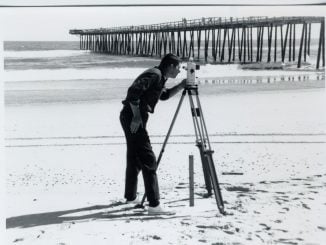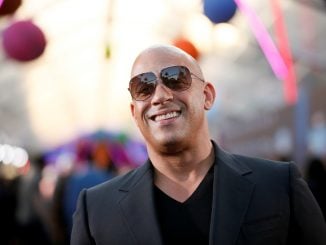
Los Angeles – The Beatles were always breaking new ground, and on August 15, 1965, they did so again by essentially creating the stadium tour, as detailed in Ron Howard’s new doc on the band’s years on the road, “Eight Days a Week.”On that date, the group played before a record crowd of 55,600 at the then-brand new William A Shea Municipal Stadium in Queens, NY. The event was filmed for posterity by their manager, Brian Epstein, and Ed Sullivan’s Sullivan Productions for a television special, a 30 minute edit of which, representing most of the concert, can be seen exclusively in theatrical showings of Howard’s film.”We felt it was a great way – both Ron’s film and Shea – for both new and veteran fans to see what a great live performing band they were, on a big screen, as it should be,” says Jeff Jones, chief executive of The Beatles’ Apple Corps Ltd. “And Shea was zenith of live performance, even according to them.”The concert was produced by promoter Sid Bernstein, who had previously brought The Fab Four to The Big Apple in February 1964, actually booking them then into Carnegie Hall for their second U.S. show nearly a year earlier, according to Dave Schwensen, author of “The Beatles at Shea Stadium.””He saw an article in a British newspaper in early 1963 that said ‘SOLD OUT.’ He booked them months before Ed Sullivan had even found out about them.”During their Summer 1964 U.S. tour, Bernstein got the idea to play them in Shea, then a new state-of-the-art sports stadium.”The biggest crowd Elvis had ever had at a stadium was 26,000 people at The Cotton Bowl,” says Schwensen, who himself saw The Beatles in 1964 in Cleveland. “The Beatles had to more than double that to fill Shea,” which they did handily.Epstein and Bob Precht, producer of “The Ed Sullivan Show” (and Sullivan’s son-in-law), knew the significance of the event, and decided to put together a TV special for a Christmas-season broadcast, and likely sell it to CBS, Sullivan’s home network.Bernstein agreed to allow them to film via a simple phone call from Sullivan/Precht.”They didn’t sign a contract or pay him anything,” Schwensen says.Precht enlisted veteran producer M. Clay Adams, whose Clayco Films would often capture outdoor, man-on-the-street segments for Sullivan and Jackie Gleason alike, to shoot the show. Adams had been brought out from New York to Hollywood in the 30s by his high school sweetheart, Oscar-winning actress Claire Trevor, who was getting her own start at Fox at the time, according to Adams’s son, Michael. He spent his first years assisting Fox executive Sol M. Wurtzel, working on Charlie Chan pictures and other films, eventually moving to RKO to create popular Picture People celebrity newsreels. After working for the Navy during World War II making training and propaganda shorts, he landed in New York City, in time for the start of the Golden Age of Television, working on “The Phil Silvers Show” and “The Defenders,” as well as directing the Emmy-winning “Victory at Sea” series for NBC.Adams had a stable of top notch camera and audio specialists he brought to Shea. The concert was recorded by Fred Bosch, known for his work recording many Cinerama feature films of the 1950s. Post work/mixing was done by the legendary Bob Fine, known for his Living Presence early stereo album series – and for helping create the six-track sound system for Cinerama. The film was shot by cinematographer Andrew Laszlo, later of “Poltergeist II” and “Star Trek V” fame.”He was a close family friend. My dad put Andy in the business,” says Michael Adams.Laszlo shot the concert using twelve 35mm cameras, plus a handheld 16mm which followed the band through its visit, manned by a plethora of great operators, including future Oscar-winning cinematographer Gordon Willis.”Andy and my dad worked off a blueprint of the stadium to figure out the best camera locations,” including a three-man silo placed just in front of the stage – where the 13-year-old Michael Adams watched the show.The operators were synchronized using a set of wind-up alarm clocks, to help them swap out film magazines at times which would hopefully avoid loss of coverage – though things didn’t quite work out as planned.”Except for two handheld cameras up in the stands, most of them ran out of film during the second number, ‘She’s a Woman,'” Adams says, resulting in that song’s absence from the film.The show was quickly edited in September, with a November cut resulting in the dropping of George Harrison’s rendition of Carl Perkins’s “Everybody’s Trying to Be My Baby.” That clip, plus other trims and outtakes, were scrapped after the show aired – leaving only the TV special’s cut camera negative as the only source for future releases or footage clips.The complexity of the stadium recording – engineers could barely hear anything, due to the tumultuous audience screaming – led to some flaws in the audio, the band and their producer, the late Sir George Martin, insisting on overdubs and redos of some tracks in January 1966. Those overdubs forced the abandonment of the Christmas ’65 airing. The show did air in May 1966 in England on the BBC, but it wasn’t until early January 1967 that the TV special aired in the U.S. on ABC, CBS having long lost interest.”The era of the ‘four Moptops’ Beatlemania was over by then,” says Schwensen. “They were already recording ‘Sergeant Pepper.'”The film was seen at midnight showings and fan conventions over the years, and was eventually restored by Apple in 1991 by archivist Ron Furmanek, though it remained unreleased. For the new theatrical showings, the camera negative was restored by Deluxe in London, and the soundtrack remixed anew by Giles Martin, Sir George’s son, and engineer Sam Okell at Abbey Road Studios.The theatrical piece, trimmed by film editor Matthew Longfellow to eliminate the non-Beatles performances seen in the original TV special, still gives fans the core experience.”You see, even as they struggled to hear themselves amidst that crowd, just what great musicians they were and how much fun they had performing,” says Jeff Jones. “It’s infectious.”



